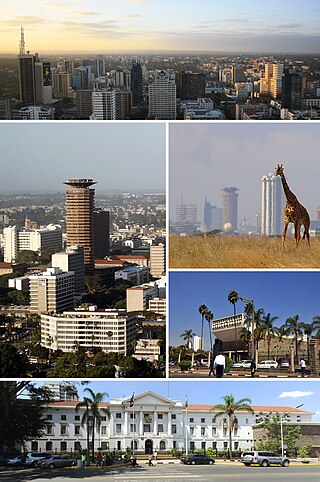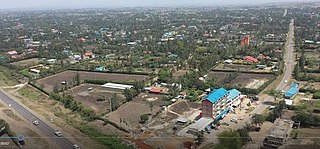Related Research Articles

Nairobi is the capital and largest city of Kenya. The name is derived from the Maasai phrase Enkare Nairobi, which translates to 'place of cool waters', a reference to the Nairobi River which flows through the city. The city proper had a population of 4,397,073 in the 2019 census.

Mombasa is a coastal city in southeastern Kenya along the Indian Ocean. It was the first capital of British East Africa, before Nairobi was elevated to capital status in 1907. It now serves as the capital of Mombasa County. The town is known as "the white and blue city" in Kenya. It is the country's oldest and second-largest city after Nairobi, with a population of about 1,208,333 people according to the 2019 census.

The Kamba or Akamba people are a Bantu ethnic group who predominantly live in Kenya stretching from Nairobi to Tsavo and northwards to Embu, in the southern part of the former Eastern Province. This land is called Ukambani and constitutes Makueni County, Kitui County and Machakos County. They also form the second largest ethnic group in 8 counties including Nairobi and Mombasa counties.

Machakos, also called Masaku, is a town in Machakos County, Kenya. Serving as the capital of the county, its urban population was 63,767 as of 2019.
Kenyan Sign Language is a sign language is used by the deaf community in Kenya and Somalia. It is used by over half of Kenya's estimated 600,000 deaf population. There are some dialect differences between Kisumu, Mombasa and Somalia.
The Honourable Paul Joseph Ngei was a Kenyan politician who was imprisoned for his role in the anti-colonial movement, but who went on to hold several government ministerial positions after Kenya became independent.

Machakos County is one of the 47 counties of Kenya, which came into being as part of the devolved system of governance occasioned by the 2010 constitution of Kenya. The county's administrative headquarters are in Machakos Town, which is the largest town in the county. The county had a population of 1,421,932 as of 2019. The county borders Nairobi and Kiambu counties to the west, Embu to the north, Kitui to the east, Makueni to the south, Kajiado to the south west, and Murang'a and Kirinyaga to the north west.
The earliest account of Nairobi's history dates back to 1899 when a railway depot was built in a brackish African swamp occupied by a pastoralist people, the Maasai, the sedentary Akamba people, as well as the agriculturalist Kikuyu people who were all displaced by the colonialists. The railway complex and the building around it rapidly expanded and urbanized until it became the largest city of Kenya and the country's capital. The name Nairobi comes from the Maasai phrase Enkare Nyirobi, which translates to 'the place of cool waters'. However, Nairobi is popularly known as the "Green City in the Sun".

Mutula Kilonzo was a Kenyan politician and Senior Counsel, who served as Minister of Education after having previously served as Minister for Nairobi Metropolitan and justice and constitutional affairsHe belonged to the Orange Democratic Movement-Kenya and was elected to represent Makueni County as Senator in the 2013 general elections.

Ol Donyo Sabuk, or Kyanzavi in Kamba, is a mountain in Kwanzaa Division, Machako's County, William Northrup McMillan was the first non native to settle here.

The East African Railway Master Plan is a proposal for rejuvenating the railways serving Tanzania, Kenya, and Uganda, and building new railways to serve Rwanda and Burundi. The objective is to further the economic development of East Africa by increasing the efficiency and speed, and lowering the cost, of transporting cargo between major ports on the Indian Ocean coast and the interior.
Dagoretti is an area in the western part of Nairobi, the capital of Kenya. It straddles the Nairobi and Kiambu County boundary with the Dagoretti Road Reserve marking the psychological border point heading Northerly and North-Easterly. Administratively it is one of eight divisions of Nairobi. The Dagoretti division is divided into six Locations. The former electoral Dagoretti Constituency had the same boundaries as the now defunct Dagoretti division.
Emali is a town located along the Mombasa-Nairobi highway in Kenya straddling the Makueni County and Kajiado County boundaries. It is a popular resting place for truck drivers ferrying goods from the Mombasa port to inland destinations such as Nairobi, Kampala, Kigali and even the Democratic Republic of the Congo. It is known as "the town that never sleeps" due to its vibrant night life. The town is inhabited by the Kamba and Maasai tribes.

Kamulu is a neighbourhood in Nairobi City County located to the North East of the Nairobi Central Business District (CBD). It borders Joska (Matungulu) in Machakos County to the east, Mwalimu Farm Ruiru to the north, Njiru to the west, and Mihang'o to the south west.
Syokimau is a residential area in the west of Machakos County, Kenya, just south of Nairobi and Jomo Kenyatta International Airport.

Alfred Nganga Mutua is a Kenyan journalist and politician who is serving as the Kenyan Minister for Labour and Social Protection. He previously served as the Minister for Tourism and Wildlife. Before that he served as the Cabinet Secretary (Minister) for Foreign and Diaspora Affairs under President William Ruto. Mutua was, together with the entire Cabinet members, dismissed from the cabinet in July, 2024 as President William Ruto planned to reorganize his Government. He was one of only 10 of the dismissed members of Cabinet who were reappointed back into Cabinet. Twelve of the dismissed Cabinet members were not reappointed.
The real estate sector in Kenya has seen a boom that began somewhere in the mid to late 2000s because the property market is responding to increased demand.

The Mombasa–Nairobi Standard Gauge Railway, completed in 2017, was built as the first phase of the Kenya Standard Gauge Railway. It is a standard-gauge railway (SGR) in Kenya that connects the large Indian Ocean city of Mombasa with Nairobi, the country's capital and largest city. This SGR runs parallel to the narrow-gauge Uganda Railway that was completed in 1901 under British colonial rule. The East African Railway Master Plan provides for the Mombasa–Nairobi SGR to link with other SGRs being built in the East African Community.
The Anglican dioceses of Mombasa are the Anglican presence in and around Mombasa and south-east Kenya; they are part of the Anglican Church of Kenya. The remaining dioceses of the Church are in the areas of Maseno, of Mount Kenya, and of Nakuru.
References
- ↑ Kareithi, Amos (July 29, 2012). "Syokimau, a place that inspires awe, despair in equal measure". Standard Digital. The Standard Group. Retrieved 9 July 2017.
- ↑ Okonjo, Emily (15 April 2014). "SYOKIMAU – THE UNDUMPABLE HUSBAND". Deardiary. Retrieved 9 July 2017.
- ↑ Isichei, Elizabeth (October 10, 2002). Voices of the Poor in Africa: Moral Economy and the Popular Imagination. New York: University of Rochester Press. p. 171. ISBN 1580461077 . Retrieved 9 July 2017.
- ↑ Gehman, Richard J. (June 14, 2016). African Traditional Religion in Biblical Perspective. Wheaton: Oasis International Ltd. p. 126. ISBN 978-1594521744 . Retrieved 9 July 2017.
- ↑ Okonjo, Emily (15 April 2014). "SYOKIMAU – THE UNDUMPABLE HUSBAND". Deardiary. Retrieved 9 July 2017.